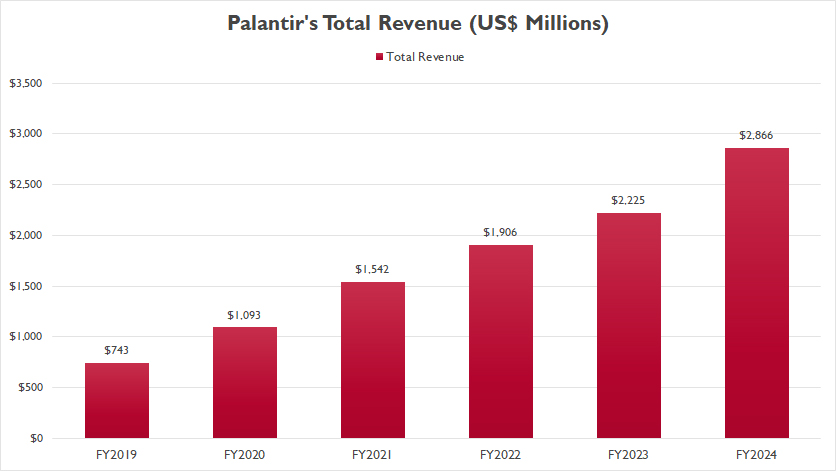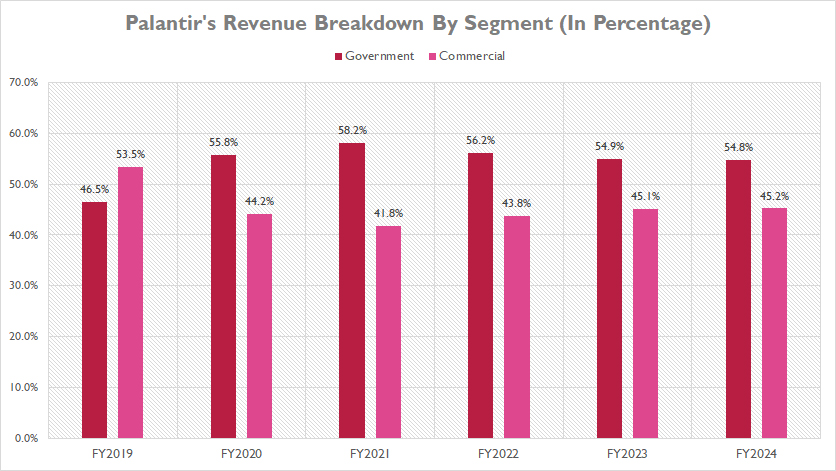
Software application. Pexels Images.
Palantir Technologies Inc. (PLTR) is a public American company specializing in software platforms for big data analytics.
Founded in 2003 by Peter Thiel, Stephen Cohen, Joe Lonsdale, and Alex Karp, Palantir is headquartered in Denver, Colorado. The company’s name is derived from “palantíri,” the magical seeing-stones in J.R.R. Tolkien’s “The Lord of the Rings.”
This article looks at Palantir’s revenue breakdown by segment. Palantir’s businesses consists of two divisions: Government and Commercial. Palantir derives slightly higher revenue from its Goverment division. However, the company’s Commercial segment has experienced much higher revenue growth in recent years.
Let’s look at the details!
Investors interested in Palantir’s key statistics may find more resources on these pages:
- Palantir revenue by country,
- Palantir profit breakdown by segment, and
- Palantir vs Nvidia: R&D comparison.
Please use the table of contents to navigate this page.
Table Of Contents
Definitions And Overview
O2. How Does Palantir Generate Revenue?
O3. Palantir Business Model
Consolidated Result
A1. Total Revenue
Revenue By Segment
B1. Revenue From Goverment And Commercial Segments
B2. Percentage Of Revenue From Government And Commercial Segments
Growth Rates of Revenue By Segment
C1. YoY Growth Rates Of Total Revenue And Revenue By Segment
Summary And Reference
S1. Summary
S2. References and Credits
S3. Disclosure
Definitions Of Segments
To help readers understand the content better, the following terms and glossaries have been provided.
Government: Palantir’s Government division refers to its business operations involving contracts and services provided to government agencies, primarily in the United States. Here are some key points:
- Contracts and Services: Palantir provides a range of services, including data analytics, artificial intelligence (AI) platforms, and software solutions for military and defense purposes. For example, Palantir recently won a $100 million contract from the U.S. Department of Defense for AI tools that identify targets for air strikes.
- AI Platform: Palantir’s Artificial Intelligence Platform (AIP) is a key product in this segment, enabling government agencies to analyze vast amounts of data and derive actionable insights.
This segment is a significant part of Palantir’s business, contributing to a substantial portion of their revenue and profit.
Commercial: Palantir’s Commercial segment focuses on providing data analytics and artificial intelligence (AI) solutions to businesses and organizations outside of the government sector. Here are some key points:
- Product Offerings: Palantir’s commercial clients benefit from its Artificial Intelligence Platform (AIP), which helps organizations analyze large datasets and derive actionable insights.
- Customer Base: The Commercial segment includes a diverse range of clients across various industries, such as finance, healthcare, manufacturing, and technology.
- Revenue Growth: The commercial segment has experienced significant revenue growth in recent years, with commercial revenue surging 29% in the most recent period.
- AI Bootcamp: Palantir’s “AI Bootcamp” workshops provide customers with hands-on experience with AIP for creating AI solutions, drawing in new customers.
This segment is crucial for Palantir’s overall growth, especially as it seeks to balance its reliance on government contracts with a strong commercial presence.
How Does Palantir Generate Revenue?
Palantir generates revenue through several key streams, primarily focusing on its software platforms and services. Here are the main sources of revenue:
1. Software Licensing: Palantir charges clients licensing fees for access to its powerful data integration and analytics platforms. These fees are typically recurring, providing a steady stream of revenue.
2. Professional Services: In addition to software, Palantir offers consulting and implementation services. These services help clients integrate Palantir’s platforms into their existing systems, ensuring optimal performance and maximizing the value derived from the data analytics solutions.
3. Long-Term Contracts: Particularly in the government sector, Palantir secures long-term contracts that provide predictable and stable revenue. These contracts often include not just software licensing, but also ongoing support and customization services.
4. Subscription-Based Models: For its commercial clients, Palantir often employs a subscription-based pricing model. This allows companies to pay for the software on a monthly or annual basis, aligning the costs with their budget cycles and usage patterns.
5. Data Integration and Migration: Palantir assists clients in migrating their existing data to its platforms, ensuring a seamless transition. This service is particularly valuable for organizations with complex data environments, and it often comes with additional fees.
By leveraging its unique products and strategies, Palantir effectively generates revenue and supports its growth objectives.
Palantir Business Model
Palantir’s business model revolves around empowering organizations to make data-driven decisions by providing powerful software platforms and services. The company focuses on collaboration and integration, helping clients solve complex problems and improve their operations.
Total Revenue
palantir-total-revenue
(click image to expand)
Palantir Technologies achieved a total revenue of $2.9 billion in fiscal year 2024, marking an impressive increase of over 29% compared to the previous year’s $2.2 billion. This upward trend is a continuation of Palantir’s consistent growth, as evidenced by the $1.9 billion in revenue recorded in fiscal year 2022.
Palantir’s financial performance over recent years underscores its rapid expansion and market penetration. Since fiscal year 2019, the company’s total revenue has more than quadrupled, soaring from $700 million in 2019 to nearly $3.0 billion by 2024.
This substantial growth reflects Palantir’s successful strategy in both its Government and Commercial business segments, capturing new market opportunities and expanding its client base.
Revenue From Goverment And Commercial Segments
palantir-revenue-breakdown-by-segment
(click image to expand)
Palantir’s segments consist of Government and Commercial. The definitions of Palantir’s segments are available here: Government and Commercial.
Palantir Technologies has consistently generated higher revenue from its Government segment compared to its Commercial segment, as illustrated in the chart above.
In the fiscal year 2024, Palantir’s revenue from the Government division soared to a record $1.6 billion, while the Commercial segment earned $1.3 billion.
When comparing the revenue in 2024, the Government division’s income was 28% higher than that of the Commercial segment. Despite this, the Commercial segment recorded a slightly higher growth rate of 29% compared to the previous year.
Looking at the longer-term perspective, Palantir’s Commercial segment has demonstrated significantly faster growth.
From fiscal year 2021 to 2024, revenue from the Government division increased by 75%, while the Commercial segment experienced a remarkable 100% growth rate. This trend highlights the robust expansion of Palantir’s Commercial segment and its potential for future growth.
Percentage Of Revenue From Government And Commercial Segments
palantir-revenue-breakdown-by-segment-in-percentage
(click image to expand)
Palantir’s segments consist of Government and Commercial. The definitions of Palantir’s segments are available here: Government and Commercial.
Overall, Palantir’s Government segment has consistently accounted for a higher revenue contribution compared to the Commercial segment, as demonstrated in the accompanying graph. In fiscal year 2024, the Government segment contributed 55% of the total revenue, while the Commercial segment represented 45%.
Looking at the longer-term trend from fiscal year 2019 to 2024, the revenue share from the Government division has notably increased, climbing from 46.5% to 55% over five years. It reached its peak at 58% in fiscal year 2021 before gradually declining to 55% by 2024.
Conversely, during the same period, the revenue contribution from Palantir’s Commercial segment has decreased from 53.5% to 45%. Despite this decline, the Commercial segment has experienced faster revenue growth in recent years. Specifically, Palantir’s revenue contribution from the Commercial segment has surged from 42% in 2021 to 45% in 2024.
This trend highlights the dynamic nature of Palantir’s revenue streams and underscores the importance of both segments in driving the company’s overall growth and success. While the Government segment continues to be a major revenue source, the rapid growth of the Commercial segment indicates its increasing significance in Palantir’s business strategy.
YoY Growth Rates Of Total Revenue And Revenue By Segment
palantir-revenue-growth-rates
(click image to expand)
Palantir’s segments consist of Government and Commercial. The definitions of Palantir’s segments are available here: Government and Commercial.
Palantir experienced a notable resurgence in revenue growth during fiscal year 2024, following a period of substantial slowdown in fiscal year 2023. In fiscal year 2024, Palantir’s overall revenue growth reached an impressive 29% year-over-year, a significant improvement compared to the 17% growth observed in fiscal year 2023.
In particular, Palantir’s Government segment showed remarkable performance, with revenue growth accelerating to 28% in fiscal year 2024, up from a modest 14% in the previous year. This surge underscores Palantir’s strong foothold and expanding influence within governmental contracts and projects.
The Commercial segment of Palantir also demonstrated robust expansion in fiscal year 2024, achieving a year-over-year growth rate of 29%, a marked increase from the 20% growth recorded in fiscal year 2023. This growth highlights the effectiveness of Palantir’s strategic initiatives and solutions in the commercial sector, as well as its ability to capture new market opportunities and clients.
On average, between fiscal years 2022 and 2024, Palantir’s total revenue exhibited an annual growth rate of 23%. In the same period, the Government division recorded an average annual growth rate of 21%, reflecting steady and consistent gains.
The Commercial segment, however, outpaced both the total revenue and the Government division, with an impressive average annual growth rate of 26% from fiscal years 2022 to 2024. This higher growth rate illustrates Palantir’s strong performance and strategic emphasis on expanding its commercial footprint.
In summary, Palantir’s Commercial segment has outperformed the Government division in terms of growth rate, showcasing significantly higher momentum and success in capturing market opportunities within the commercial realm. This robust performance highlights Palantir’s balanced growth across both segments, with a stronger inclination towards commercial sector expansion.
Conclusion
To summarize, Palantir has achieved significant revenue growth from fiscal year 2019 to 2024, with an average annual growth rate of approximately 23% over the past three years.
The Government segment generates slightly higher revenue for Palantir, contributing $1.6 billion in fiscal year 2024, which accounts for 55% of the total revenue.
Conversely, the Commercial segment contributed 45% of Palantir’s revenue in fiscal year 2024, amounting to $1.3 billion.
Regarding revenue growth, Palantir demonstrates balanced growth across both the Government and Commercial sectors, with the Commercial segment showing higher growth rates.
This balanced growth strategy enables Palantir to capitalize on opportunities in both governmental and commercial markets, ensuring a diversified revenue stream.
References and Credits
1. All financial figures presented were obtained and referenced from Palantir’s annual reports published on the company’s investor relations page: PLTR Financial Reports.
2. Pexels Images.
Disclosure
We may use the assistance of artificial intelligence (AI) tools to produce some of the text in this article. However, the data is directly obtained from original sources and meticulously cross-checked by our editors multiple times to ensure its accuracy and reliability.
If you find the information in this article helpful, please consider sharing it on social media. Additionally, providing a link back to this article from any website can help us create more content like this in the future.
Thank you for your support and engagement! Your involvement helps us continue to provide high-quality, reliable content.




